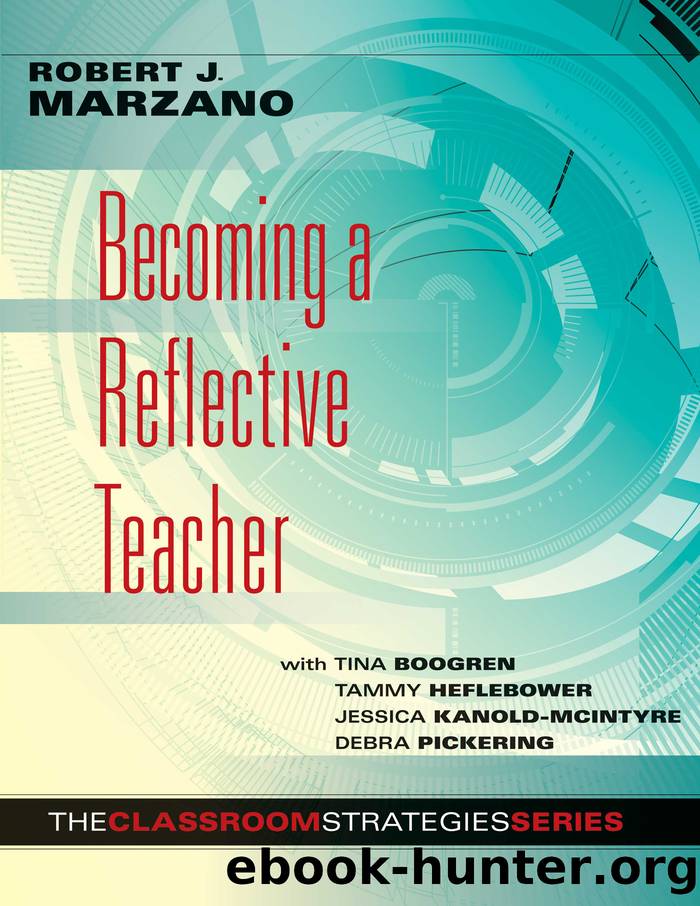Becoming a Reflective Teacher by Marzano Robert J.;Boogren Tina;

Author:Marzano, Robert J.;Boogren, Tina;
Language: eng
Format: epub
Publisher: Marzano Research Lab
Published: 2019-08-15T00:00:00+00:00
COMPENDIUM CONTENTS
LESSON SEGMENTS INVOLVING ROUTINE EVENTS
Design Question: What will I do to establish and communicate learning goals, track student progress, and celebrate success?
Element 1: What do I typically do to provide clear learning goals and scales (rubrics)?
Element 2: What do I typically do to track student progress?
Element 3: What do I typically do to celebrate success?
Design Question: What will I do to establish and maintain classroom rules and procedures?
Element 4: What do I typically do to establish and maintain classroom rules and procedures?
Element 5: What do I typically do to organize the physical layout of the classroom?
LESSON SEGMENTS ADDRESSING CONTENT
Design Question: What will I do to help students effectively interact with new knowledge?
Element 6: What do I typically do to identify critical information?
Element 7: What do I typically do to organize students to interact with new knowledge?
Element 8: What do I typically do to preview new content?
Element 9: What do I typically do to chunk content into digestible bites?
Element 10: What do I typically do to help students process new information?
Element 11: What do I typically do to help students elaborate on new information?
Element 12: What do I typically do to help students record and represent knowledge?
Element 13: What do I typically do to help students reflect on their learning?
Design Question: What will I do to help students practice and deepen their understanding of new knowledge?
Element 14: What do I typically do to review content?
Element 15: What do I typically do to organize students to practice and deepen knowledge?
Element 16: What do I typically do to use homework?
Element 17: What do I typically do to help students examine similarities and differences?
Element 18: What do I typically do to help students examine errors in reasoning?
Element 19: What do I typically do to help students practice skills, strategies, and processes?
Element 20: What do I typically do to help students revise knowledge?
Design Question: What will I do to help students generate and test hypotheses about new knowledge?
Element 21: What do I typically do to organize students for cognitively complex tasks?
Element 22: What do I typically do to engage students in cognitively complex tasks involving hypothesis generation and testing?
Element 23: What do I typically do to provide resources and guidance?
LESSON SEGMENTS ENACTED ON THE SPOT
Design Question: What will I do to engage students?
Element 24: What do I typically do to notice when students are not engaged?
Element 25: What do I typically do to use academic games?
Element 26: What do I typically do to manage response rates?
Element 27: What do I typically do to use physical movement?
Element 28: What do I typically do to maintain a lively pace?
Element 29: What do I typically do to demonstrate intensity and enthusiasm?
Element 30: What do I typically do to use friendly controversy?
Element 31: What do I typically do to provide opportunities for students to talk about themselves?
Element 32: What do I typically do to present unusual or intriguing information?
Design Question: What will I do to recognize and acknowledge adherence or lack of adherence to rules and procedures?
Element 33:
Download
This site does not store any files on its server. We only index and link to content provided by other sites. Please contact the content providers to delete copyright contents if any and email us, we'll remove relevant links or contents immediately.
The Art of Coaching Workbook by Elena Aguilar(48572)
Trainspotting by Irvine Welsh(20140)
Twilight of the Idols With the Antichrist and Ecce Homo by Friedrich Nietzsche(17754)
Fangirl by Rainbow Rowell(7893)
Periodization Training for Sports by Tudor Bompa(7376)
Change Your Questions, Change Your Life by Marilee Adams(6702)
This Is How You Lose Her by Junot Diaz(5845)
Grit by Angela Duckworth(4777)
Red Sparrow by Jason Matthews(4734)
Asking the Right Questions: A Guide to Critical Thinking by M. Neil Browne & Stuart M. Keeley(4642)
Paper Towns by Green John(4209)
Room 212 by Kate Stewart(4152)
Ken Follett - World without end by Ken Follett(4003)
The Sports Rules Book by Human Kinetics(3630)
Housekeeping by Marilynne Robinson(3456)
The Motorcycle Diaries by Ernesto Che Guevara(3380)
Introduction to Kinesiology by Shirl J. Hoffman(3329)
Exercise Technique Manual for Resistance Training by National Strength & Conditioning Association(3329)
Papillon (English) by Henri Charrière(3323)
